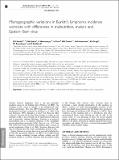| dc.contributor.author | PO Sumba, EW Kabiru, E Namuyenga, N Fiore, RO Otieno, .. | |
| dc.date.accessioned | 2020-11-19T05:50:32Z | |
| dc.date.available | 2020-11-19T05:50:32Z | |
| dc.date.issued | 2010 | |
| dc.identifier.uri | https://repository.maseno.ac.ke/handle/123456789/2839 | |
| dc.description.abstract | Background:
Endemic Burkitt's lymphoma (eBL) has been associated with Epstein–Barr virus (EBV) and holoendemic Plasmodium falciparum malaria. But recent evidence suggests that other risk factors are involved.
Methods:
We hypothesised that selenoprotein glutathione peroxidase (GPx), a surrogate of nutritional status, is an important biomarker for eBL risk. We measured plasma GPx, anthropometric markers of malnutrition, EBV viral loads and malaria parasitaemia in children aged 1–9 years (n=258) from two locations in Nyanza Province, Kenya, with higher-than-expected and lower-than-expected incidence of eBL. The study participants were malaria asymptomatic children from the community.
Results:
Children from eBL high-incidence areas had significantly lower GPx levels, high EBV viral load and more evidence of chronic malnutrition than children from eBL low-incidence areas (all P<0.001). Additionally, GPx levels were significantly lower in children with the highest EBV viral load and for those with P. falciparum infections (P=0.035 and P=0.004, respectively).
Conclusions:
These results suggest that selenium deficiency may be a risk factor for eBL.
Main | en_US |
| dc.publisher | British journal of cancer 103 | en_US |
| dc.subject | selenium deficiency; Epstein – Barr virus (EBV); malaria; endemic Burkitt’s lymphoma; pediatric cancer; malnutrition | en_US |
| dc.title | Microgeographic variations in Burkitt's lymphoma incidence correlate with differences in malnutrition, malaria and Epstein–Barr virus | en_US |
| dc.type | Article | en_US |

